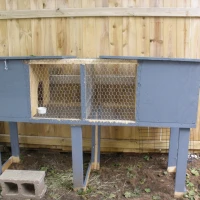When people say someone/something is, “breeding like rabbits” the implication is that they are reproducing at an unbelieveable rate. As someone trying to raise rabbits for meat, I can tell you that it isn’t nearly as easy as it sounds.
Our breeding stock, Fiona and Nibbler have been old enough to breed since January 2011. However, January in Northern Michigan can be pretty harsh and I wasn’t ready to start my breeding endeavor then only to have it result in frozen litters of baby bunnies. I waited until March. The air had warmed sufficiently and I deemed it safe to start. I took Fiona to Nibbler’s pen just like the books/internet said I should. I left her there for a while, checked back and returned her to her cage. A few hours later I let her visit again, left them alone for a bit and then put her back in her cage. I documented the date, marked the calendar and started counting down the days until she would need a nesting box. I Googled different types of nesting boxes. I waited. And waited. And waited. A week after the due date I gave up waiting.
I tried again. No luck.
I tried again. I decided that once again the pregnancy hadn’t taken. In June I asked my friend Joan from Olds’ Farm if I could bring my doe out and put her with one of the bucks they keep. Joan agreed and I planned to take Fiona to the farm next time I went.
Imagine my surprise when I awoke the next morning to find Fiona pulling her fur out and spreading it around her hutch. I needed to pick Dylan and some friends up from a sleepover and take them to a 10:00 movie. I didn’t have time to set up a real nest box before I got the boys so I put out a makeshift nest and went about my business. I intended to come home and set up a real nest box before Fiona delivered her babies because rabbits are “supposed” to deliver at night. Wrong. I got home at noon to find my husband in the yard announcing the arrival of two kits. Fiona didn’t like my makeshift box and had delivered them on the floor of the cage. Mr. Hippie had moved them into my “nest box” with a towel because he didn’t know if he should touch them or not. When everything was said and done, Fiona had delivered eleven kits. One was stillborn but we moved the ten surviving kits into the “nest”. After the horde of boys left, Mr. Hippie and I went out and got the rest of the things we needed to properly accomodate the babies.
I set up the deluxe nesting box and moved the kits into it. Fiona decided that she would dig a new nest next to the one I made. She started pulling more fur to line the new nest. I started panicking, afraid that she was going to deliver another litter of kits. (Rabbits do that, you know.) Fiona did not deliver any more kits. She did however divide her kits into two groups and move half into the new nest.
Once Fiona had completed her second nest, she promptly stopped nursing the front five kits. Fortunately, rabbits are designed to survive harsh conditions. Like, for example, your mother not coming back to feed you for a couple days because there is something dangerous lurking about your home. I moved the five littler kits that she hadn’t been nursing into “her” nest with the five bigger kits. The next morning I awoke to find two of the kits pushed out. They weren’t just pushed out of the nest either. They had somehow managed to be completely evicted from the hutch. Both were chilly and crawling around on the ground. I put them back into their nest so they could warm themselves and went on my way.
The next night I went to derby practice and left the kids home with Gwen in charge since Adam was working that night. After practice I checked my phone and found that I had missed a call. The kids know that they are only to call me in an emergency, so my heart stopped for a moment while I, without listening to the message, called the house.
Gwen was bawling on the other end of the line, “Mom, one of the rabbits died.” She was panicked, distressed, I’m not sure what else but I tried my best to talk her down. She didn’t know what to do with the dead kit. I suggested she add it to the compost heap like I had done with the stillborn kit. This solution was not acceptable to her. When I got home she had already provided funeral and burial services for the kit.
Fiona continued to push the other runty kit out of the nest for a while, but never split the nest again and begrudgingly nursed all the kits.
When all was said and done, we ended up raising nine kits from our very first litter! It took a while for the rabbits to figure out what they were doing, but in the end it was a successful endeavor.



